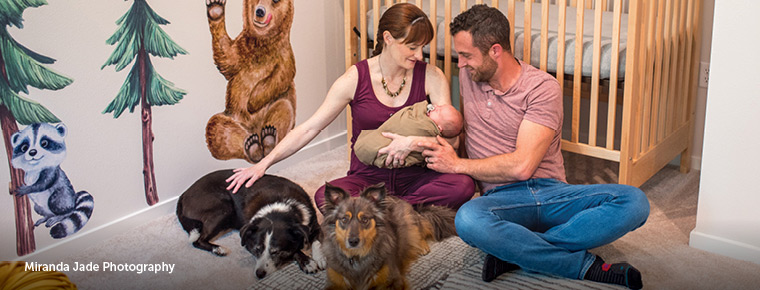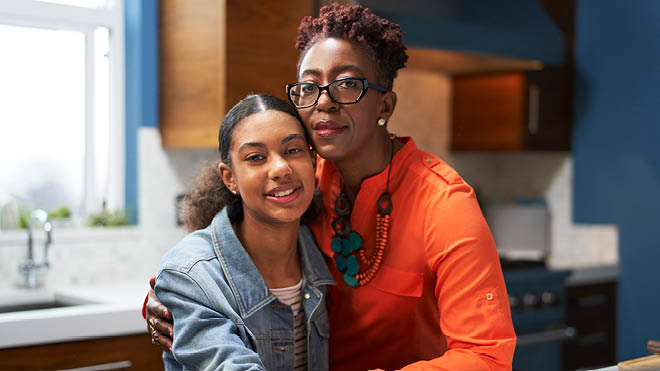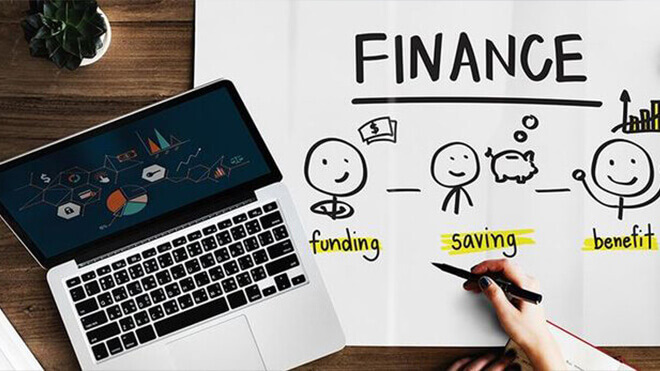
New Baby Budget: Costs for the First Year
If you're welcoming a baby into your family soon, it helps to think about upcoming one-time and recurring purchases. Even if you skip buying that spendy stroller and use hand-me-downs, you may be surprised by the costs.
Fact checked by Katie J. Skipper
Budgeting for a baby isn't easy. Of course, you've planned for big, one-time expenses like a car seat and stroller — but did you remember to budget for the monthly costs of baby food and diapers?
If you understand the costs of having a new baby, you can decide which items to include in your budget and which to skip. We'll go through the following categories and discuss a few ways to save on each:
- Strollers and baby carriers.
- Diapers and baby clothing.
- Baby toys and entertainment.
- Baby food.
- Health, including doctor visits and hygiene.
- Child care.
- Nursery equipment.
- Saving for parental leave.
How Much Should I Budget for a Baby?
Your budget should be based as closely as possible on how much you think you'll spend. A Brookings Institution analysis found that a married, middle-income family could expect to spend about $18,000 a year on raising a child. But that's if you divide up the total evenly over 17 years for a child born in 2015. In 2023 dollars, $18,000 jumps to more than $23,000, using the Consumer Price Index Inflation calculator, and that doesn't account for the higher costs of a child's first year.
Families making more money tend to spend more on their children, according to USDA.
Another survey showed how different budgeting and spending could be. New parents planned to spend around $9,371 during their child's first year, but the parents' average amount actually spent came to $13,186, according to a national survey conducted in 2019 by the website LendEDU.
It's easy to see why an estimate and final number might differ — perhaps you forgot to plan for everything. Or you didn't think you'd need a swing, but after a sleepless night, you buy one in desperation.
TIP: Your annual first-year baby expenses depend heavily on factors such as needing to pay for child care or items you requested but didn't receive on your registry. Use the Babycenter.com First-Year Baby Costs Calculator to get more in tune with your expectations.
One-Time, Recurring and Occasional Baby Costs
When you're thinking about baby expenses, first consider the big one-time costs, then think about recurring monthly expenses.
One-Time Cost Examples:
- Crib.
- Stroller.
- Car seat.
- Replacing income lost during parental leave.
Recurring Cost Examples:
- Food (formula, baby food).
- Diapers and diaper wipes.
- Child care.
- Insurance premiums.
As a new parent, you'll also need to consider costs cropping up every few months. Ideally, you'll plan for these costs, too, to avoid reaching for your credit card. For example, if you know you might need to buy a $50 baby gate at six months old, start putting away $10 per month when your baby is one month old.
Occasional Cost Examples:
- Toys, entertainment.
- Clothing as baby grows.
- Hygiene supplies.
- Haircuts.
What Are the Most Expensive Items To Budget For When Having a Baby?
One of the major expenses (30%) revolves around items that seem inexpensive at first — but add up fast, according to the LendEDU survey. These include strollers, diapers, baby clothing and more. How can you budget for these items? Let's review what's involved with budgeting for baby gear.
Strollers
While it may be possible to pick up a simple stroller for less than $20, many parents opt for strollers with more functionality — and strollers can run up to $1,000 or more for a premium model. Of course, buying a gently-used stroller on Craigslist, Facebook Marketplace or at a children's consignment or resale store is an easy way to save.
Some parents choose a sling or another type of baby carrier in addition to or instead of the stroller; these may be less expensive overall but can run from under $20 to $200 or more.
Tip: Buying a baby carrier or stroller designed to grow with your baby ensures it's a one-time cost, versus needing to return to the store as your little bundle grows.
Diapers and Changing Supplies
According to research by the National Diaper Bank Network, an infant's disposable diapers (PDF) cost $80-$100 per month in 2022. That adds up to about $1,200 for the first year. Unfortunately, diapers are taxed in Washington state at 6.5% to 9.5%, adding up to $85.50 to that total annually. If you plan to take your child swimming, you likely will need to invest in special swim diapers occasionally, too.
Changing Supplies — Recurring Costs:
- Diapers.
- Diaper wipes.
- Diaper cream (to treat and prevent diaper rash).
- Diaper pail refills.
Changing Supplies — One-Time Costs:
- Changing table and pad.
- Portable changing pad.
- Diaper bag.
- Diaper pail.
- Baby wipe warmer.
New parents don't need to buy all of these items. A wipe warmer may not be necessary, for example, and buying in bulk can save money.
Some parents choose cloth diapers, but this option comes with its own costs, including diaper covers and laundry costs, whether that's for a diaper service or the increase in utility costs from washing them yourself at home.
Baby Clothing
If it feels like your little bundle outgrows clothing in mere minutes, it's not far from the truth. Babies triple their birth weight in the first year, after all. For baby clothes, plan for five age ranges for clothing: newborn, 0-3 months, 3-6 months, 6-9 months and 12 months.
One newborn's outfit set may set you back $12 to $17 if you buy new clothes. If you use one outfit set per day of the week, that's $84 in your baby budget in the first month alone on the low end — until your baby outgrows that set. Any new parent will tell you that babies are messy, so you can expect a few outfit changes per day.
Clothing you'll need to buy every three months or so as your baby gains inches and pounds includes:
- Onesies.
- Swaddling blankets.
- Hats and mittens.
- Coats.
- Pajamas.
- Pants, dresses, tops.
- Booties, shoes, socks.
- Swimsuit.
Stretch your clothing budget by buying slightly larger items, cleaning and caring for clothes, asking for hand-me-downs and gently-used apparel from friends and family, or shopping at consignment stores.
Baby Toys and Entertainment
While baby toys may seem inexpensive, many parents don't realize the importance of entertaining babies until after they have arrived — and you need to cook dinner or have a phone conversation. Just an infant swing could cost $89 or more. Items to keep your baby happy could include these one-time and recurring purchases:
Baby Toys — One-Time Purchases
- Playpen.
- Baby activity equipment (playmat/gym).
- Bouncy seat.
- Infant swing.
Baby Toys — Recurring Purchases:
- Books.
- Toys.
Of course, babies can be entertained by library books and pots and pans, so consider less expensive, simple options. Small, inexpensive toys can also be a great baby shower gift, so friends and family might help you out there. Or you could borrow toys from another parent or family member.
Baby Food and Nursing Accessories
Feeding a baby takes up to 28% of total costs, according to the LendEDU survey. In the first six months, your baby will mostly grow with formula feeding or breastfeeding. Baby formula costs an average of $400 to $800 per month for babies who are fed only baby formula, according to babycenter.com. Even breastfeeding, which isn't always possible, can come with expenses, including nursing bras, pads and nursing-related equipment for expressing and storing milk.
Once your baby has moved onto solid foods, according to the USDA, the cost to feed a one-year-old child (PDF) is $155 to $213 per month, as of February 2023. Estimate a little less for a child under age 1.
You're also likely to go through a period of trial and error, when you're figuring out what works best for you and your baby, so you might end up buying some “one-time” items a few times.
Feeding Equipment — One-Time Cost:
- Highchair.
- Plates, bowls, cups, utensils, bibs.
- Bottles, nipples, cleaning supplies.
- Burp cloths.
- Breast pump.
- Nursing pillows.
- Nursing bras.
Hospital and Doctor Visits
You'll likely add your baby to your health insurance plan. If you're on an employer-sponsored plan, you'll probably pay an average of $6,106 toward the cost of family coverage, according to the Kaiser Family Foundation.
Your baby will also need about seven visits with a physician in the first year of life to ensure healthy growth, vaccinations and more. An insurance provider typically covers these visits if compliant with the Affordable Care Act.
In addition, you may need to take your baby to the pediatrician for common ailments such as fever, rashes or other symptoms. Budget for your deductible and copay. The average deductible for family coverage with an employer-sponsored health plan is $3,868, according to a USA Today article, and $8,439 for plans purchased outside of an employer-sponsored plan, according to eHealth, a health insurance marketplace website.
Ensuring your baby stays healthy and happy is a sneaky expense. Even if wellness visits are covered after you add your baby to your health insurance policy, you'll need to consider unplanned-urgent care visits or hospital bills, routine health and hygiene and safety equipment.
Baby Health and Hygiene
You'll also need to budget for the ongoing costs of health, which can help preventative visits turn out well. Many health and hygiene items are baby-specific — for example, tiny nail clippers for tiny toes.
One-Time Baby Health and Hygiene Expenses:
- Baby towel and washcloths.
- Baby bathtub.
- Baby skin and hair supplies (clippers, brush, comb).
- Humidifier for cold and flu season.
- Thermometer.
- Nasal aspirator.
Recurring Baby Health and Hygiene Expenses:
- Baby soap and shampoo.
- Baby sunscreen.
- Baby first-aid supplies.
- Medicine.
- Haircuts.
Child Safety Equipment
Keep your baby out of the physician's office with essential safety measures. You'll need an infant car seat to bring your baby home from the hospital. According to Washington state law, children under age two must ride in a rear-facing car seat. An infant car seat starts at around $100 but can run up to $400 or more.
Childproofing your home can include safety gates and electrical outlet covers. Often, you'll discover ever-increasing potential risks as your child becomes more active, such as climbing stairs and shelves and opening doors. According to the Consumer Product Safety Commission, parents might prioritize these items inside the house.
Safety Costs:
- Safety latches and locks for drawers and doors.
- Safety gates.
- Doorknob covers.
- Anti-scald faucet devices.
- Window guards and netting.
- Furniture cushions or bumpers.
- Outlet covers and plates.
- Smoke and carbon monoxide detectors.
- Furniture and appliance anchors.
- Cordless window coverings.
Child Care Costs and Babysitters
In Washington state, full-time infant care costs on average $19,104 ($1,592/month) in a child care center and $14,304 ($1,192/month) in a home, according to the organization Child Care Aware of Washington (PDF). Costs may be even higher in larger cities. This cost is almost equivalent to the total first-year infant costs outlined earlier and more than annual tuition at a public four-year university, according to Child Care Aware. The good news: As your child grows, child-care costs will likely decrease.
Budget for a babysitter, too, if you'd like a night out. Babysitters in Seattle with 2-5 years of experience cost about $20.25 an hour, according to babysitting rates from Care.com. If you go out for four hours per month, that's about $81 a month before tips. You could also save by asking family members to babysit or even trade babysitting duties with other parents.
Nursery Setup
One-time expenses for the nursery might include a crib or baby bed, likely one of the most expensive items to budget for, ranging from about $139 to almost $1,000. Ways to save on these nursery costs can include listing them on your baby registry or finding them used in thrift stores.
Nursery Costs:
- Crib mattress, bedding.
- Co-sleeper.
- Glider or rocking chair.
- Dresser.
- Lamp and other decor.
- Nightlight.
- Clothes hamper.
- Baby monitor.
Saving for Parental Leave
After your baby's birth or adoption, you may be eligible for up to 12 weeks of unpaid family leave under the federal Family and Medical Leave Act. However, you'll need to budget for the loss of household income during parental leave, whether one parent or both will take time off.
If you live in Washington, you might qualify for paid leave. You could receive up to 90% of your weekly pay or up to $1,427 in 2023.
Miscellaneous Baby Costs That Could Impact Your Budget
Here are a few additional factors that often come with having a child that lead to increased costs:
- A bigger house.
- Using more electricity, gas and water.
- Driving more, which burns more fuel.
An often-cited USDA report (PDF) estimates that the highest costs in the first two years include housing, child care and transportation. (The report hasn't been updated since 2017, but the relative costs of housing, child care and transportation are likely the same.)
If you need to increase your bedroom count to give your child a room, first-year costs can skyrocket, particularly in the Seattle area. You may use more utilities if you're washing cloth diapers or onesies, or heating and lighting an extra bedroom. You might feel a larger vehicle with more room is necessary. All the above could lead to higher monthly payments in the form of a mortgage or rent, utility bills or a car loan.
How To Avoid Debt When Having a Baby
Some LendEDU-surveyed parents turned to debt to make up the difference, racking up an average of $6,144 in debt. In some cases, debt was partly the result of reduced income for parents who left the workforce or took a part-time job so they could care for their child.
Tips To Avoid Debt When Having a Baby:
- Avoid overspending by reviewing all possible expenses for your baby's first year.
- Consider the benefits of a joint bank account for shared baby expenses.
- Decide which average baby items or decisions you might want versus need.
- Research pricing for first-year items and decide if you'll get them new, used, borrowed — or request the items as gifts for your baby shower.
- Prioritize cost savings for diapers, clothes, food and child care if possible since these items are top baby budget expenses.
- Boost your emergency fund in a savings account to help cover unexpected expenses such as medical bills or a hospital stay.
- Try to resist spending based on emotion (impulse buying that cute new infant outfit or fancy stroller).
If you are already in debt, you can use our debt calculator to understand your current debt situation clearly. Then take steps to reduce your debt by paying more than the minimum, being conscious about spending choices, and getting assistance if necessary. If credit cards make up most of your debt, choose a strategy that works for you, like the debt snowball method, to manage and reduce your debt.
If your baby hasn't arrived yet, practice living on your cash flow and budget for several months to ensure you have enough money to live on or can still allocate money toward your financial goals like retirement savings. Consider signing up for a BECU Financial Health Check to assess your budget and overall financial health.
Helpful Resources for Seattle-Area Parents
Budgeting for that first baby in a high-cost area like Seattle can be especially challenging. Consider these resources for extra help, or think about donating cash, time or items to the following organizations:
FamilyWorks Seattle: Offers the chance to “shop” for free kids' clothing from a closet of used apparel, nutrition programs for families with children under age 5, playgroups, and referrals to other food and transportation assistance.
Help Me Grow Washington Hotline: Helps Washington state parents apply for resources, including basic food and insurance coverage.
Westside Baby: Works with partners to provide diapers, car seats and more, including one-time diaper distributions.
Childcare Aware of Washington: Provides referrals for child care and connects families with resources to help pay for child care costs.
There's good news on the horizon for new Washington parents, too. Washington moms and dads may benefit from a new law (PDF), effective Nov. 1, 2023, which will give a monthly diaper subsidy to parents or caregivers receiving Temporary Assistance for Needy Families (TANF).


